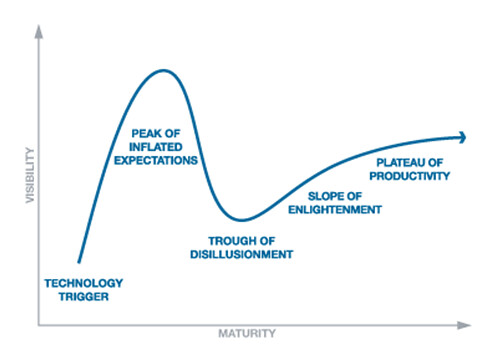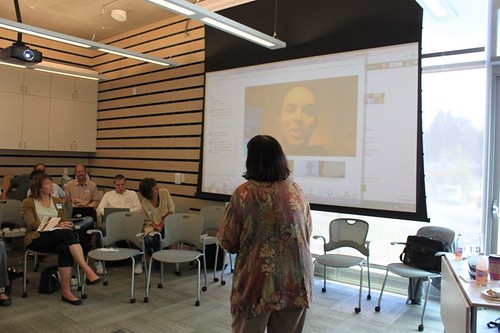
Last week, I helped launch a peer exchange Webinar for Packard Foundation for Children’s Health Insurance grantees with Spitfire Communications (creators of the SMART chart). The focus is how to effectively integrate social media channels and measure and learn. Two grantees that work on Children’s Healthcare at the national level and have experience using social media as part of an integrated campaign were co-presenters. Kristin Rowe-Finkbeiner co-founder of Momsrising and Bruce Lesley, President, of First Focus. (I learned so much that I enough material for several blog posts, my first post is here – it is about content curation.)
While this Peer Exchange starts off with best practices on Facebook, it is a means to a higher end: how to apply and integrate those principles into the organization’s broader children’s health communications strategies. Organizations can get comfortable with implementing one channel and expand to other channels as part of their maturity of practice model. Capacity building that takes an incremental approach and is a balance of strategy and action leads to capacity building that sticks.
We launched this project just as Google + open its doors to a limited field testing and was being touted as a Facebook or Twitter killer by early adopter geeks and Silicon Valley insiders. No surprise that Principle #1: Avoid being seduced by Shiny Object Syndrome generated great insights. My colleague Geoff Livingston says that “Shiny Object Syndrome” makes nonprofits and individuals to adopt the latest cool social tool based on peer pressure, buzz, or a strange desire to be one of the first.

I’m not recommending that all nonprofits should immediately just say no (or yes) to the latest technology tool that is capturing the imagination (and time) of geeks. But, it is important to have a framework like Gartner Technology Hype Cycle to think it through. There are three choices:
Early Move: Willing to combine risk taking with an understanding that risky investments don’t always pay off.
Moderate Approach: Understand the argument for an early investment but will also insist on a sound cost/benefit analysis when new ways of doing things are not yet fully proven.
Wait for maturation? If there are too many unanswered questions about the impact of the technology platform, better to wait until others have been able to deliver tangible value.

During the Webinar, I polled the group’s general approach. Kristin Rowe-Finkbeiner co-founder of Momsrising and Bruce Lesley, President, of First Focus share their approaches.
Momsrising is an early adopter of online tools currently exploring the Google + platform and discussing it in team meetings. However, as Kristin points out “we use a cost/benefit analysis as we go along.” They have several staff persons testing the connectivity to other people and trying to understand the potential, mostly as individuals talking about their professional work. Kristin notes that they ask staff members to carefully track their time. “This type of exploration should not become a time suck or get in the way of established organizational priorities.”
It is easier for Momsrising to explore new platforms because they’ve already established a strong presence on many social media platforms and are using mobile. Kristin says, “If Momsrising haven’t already built strong networks on platforms like Facebook or Twitter – which are known to work for nonprofits – we’d be focusing our time and energy there first.”
Bruce Lesley said his organization takes a moderate approach with new platforms as an organization. Bruce notes, “I was one of those people who said, not too long ago, that we’d never be on Twitter. But I decided to become a leader, not a barrier.” Bruce’s individual participation and organizational presence on social media is part of an integrated strategy that has brought value, particularly in reaching influencers. In general, they tend to wait until the kinks in the platform are worked out and there is less risk involved investing staff time.
Right now Google + is still in the very early stages of development and has potential to add a social layer to the Web as David Armano points out. The early adopter love fest has given way to some rants about the platform and what isn’t working. People are also discovering what the social etiquette is around “circling” people, the google + way of friending people. But, it is important to point out that the Google + team is listening and improving features – with its “Feedback Friday” so the landscape is changing rapidly.
Can Google + be a good platform for social change activists? Short answer: too early to tell.
I’ve been noticing that I tend to get more engagement on technology posts than social engagement posts, although when I worked hard at stirring the pot, there have been a few productive conversations. The problem with Google + as it stands right now (and it will be changing) is that lack of community features and mainstream adoption. The community features – open circle lists – allows activists to sustain conversations which is important to organizing and to the serendipity to discover new people who may have interest in your cause. (A few early adopters have hacked some tools for us social activists and nptechers reminding me of the early hacks that people did on Twitter before they launched Twitter Lists.)
Jeremiah Owyang has a good analysis of what features Google + needs to go mainstream. He talks about the importance of Google implementing brand pages.
What are the potential uses for nonprofits? Ivan Booth is doing a meet up and live stream for the Philly Netsquared meet up on August 2nd at 6:00 PM EST about Google +. You can find the information for the meet up in my collection of Google + and Nonprofit Links.

Just for giggles, I started a thread on Google + to do an interview with nonprofits and social activists exploring Google + as part of some preparation for an interview with Alison Fine for the Social Good Podcast. The following is framed with one disclaimer: We’re in the days and this could all change.
What struck me most about the conversation is that consultants, early adopter nonprofits, and free agents all agree that the platform is evolving fast and there is still too much uncertainty for nonprofits to invest a lot of time and resources in Google +. Nedra Weinreich says, “Until we know whether G+ is going to attract more than just us social media types, I’m hesitant to recommend that any organizations invest too much time in it. I think pulling people off Facebook is going to be a challenge.” Shawn Ahmed, a free agent fundraiser, concurs, “We don’t know what the space will be for social change activists.”
Nonprofit organizations that have been early adopters of social media are exploring, like Momsrising, carefully. Danielle Bridiga, from the NWF, says “I’m still not sure if it’s going to hold out and join Twitter and Facebook but I think it’s certainly kept my attention a bit longer than other flash in the pan platforms.” NWF is in the “imaging” stage of what the potential is for the platform. Manny Hernandez from the Diabetes Hands Foundation shares that he is listening and playing, but adds similar advice to Kristin from Momsrising, “If my nonprofit wasn’t an early adopter, I would not start here too much territory to explore yet and too many intangibles still.” As Marc Pittman and others note, many nonprofits are overwhelmed or set in their ways on Facebook to energize to change habits.
Here’s quick summary of points from the discussion:
- Nonprofit folks are exploring Google + as individuals and talking about their organization’s work and building relationships with influencers like technologists and journalist early adopters on the platform.
- They are eager for the platform to gain critical mass so the promise of Google + for social activism can be realized
- A few activists for privacy rights have had active conversations. Take for example the conversations Jillian York is having on the platform.
- The Google Hangout (Group video chat) has some potential to be useful for learning. I’ve experimented using it bring in a couple of remote experts to join the conversation. It could also be used at conferences. I also did a hangout with my 90 year old dad who said it was more entertaining than watching Jeopardy.
- The privacy features allows organizations to have conversations with specific groups of people. This could be useful for donor cultivation or working with small groups – much like some organizations have used “secret Facebook” groups to interact with brand or issue ambassadors.
- Some have seen some early benefits of getting web site traffic
I’m not ignoring it, but I’m carefully establishing efficient habits. I’m using a combination short blog posts, participating on other people’s threads, and using it as a source for curating information. The best of the best about the platform and nonprofits, I’m adding to my curated list in Scoop.it, because the platform lacks bookmarking and filtering features. I’m not abandoning my other networks on Twitter, Facebook, or SlideShare, but looking at how to best build relationships and conversational bridges between communities and people I interact with on the different platforms. I am avoiding spamming all three networks with cut and paste streams. I am also experimenting with techniques for network weaving across platforms and curating content related to effective practice of networked nonprofits.
Update: Will You Leave Facebook for Google+? – Brian Solis provides an analysis of its users and growth.
Have you been exploring the potential of Google+ for your nonprofit or social activism? What do you think?
